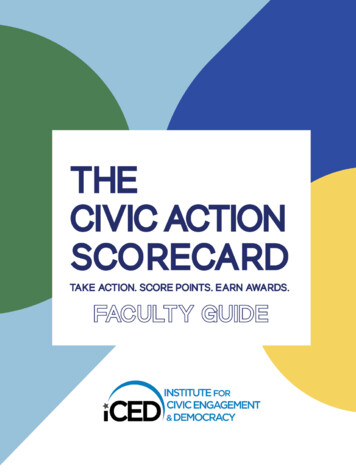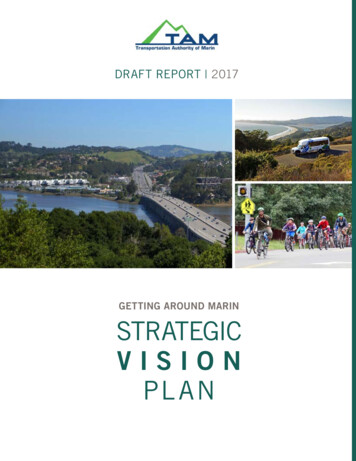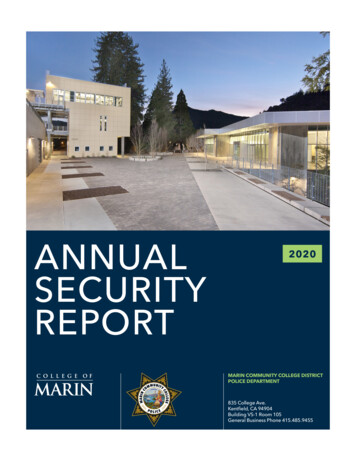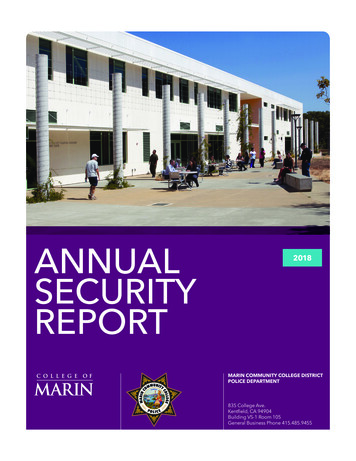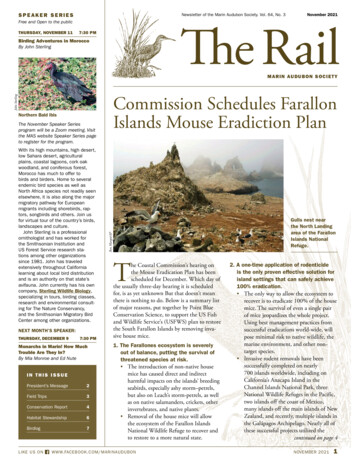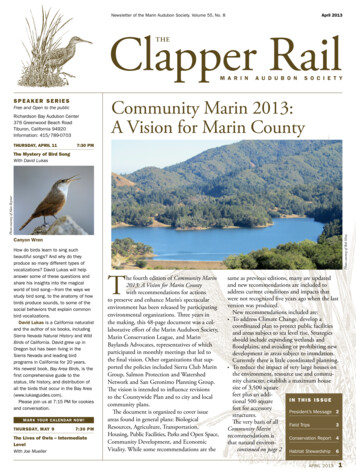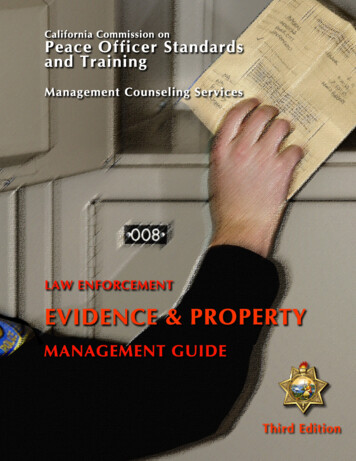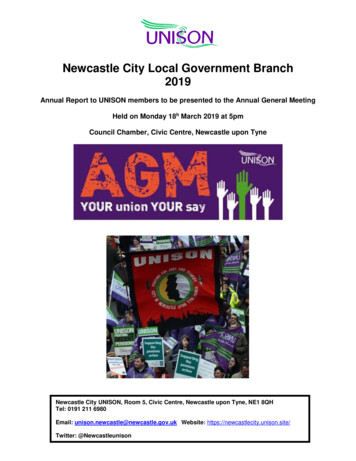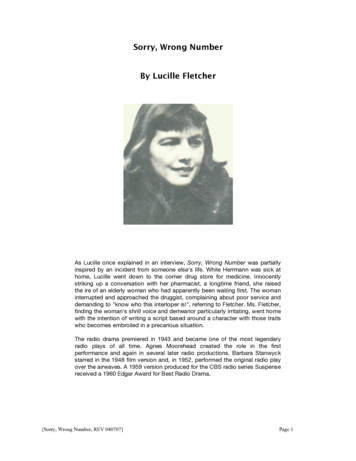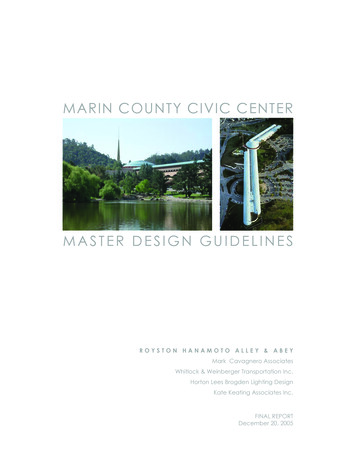
Transcription
MARIN COUNTY CIVIC CENTERMASTER DESIGN GUIDELINESROYSTON HANAMOTO ALLEY & ABEYMark Cavagnero AssociatesWhitlock & Weinberger Transportation Inc.Horton Lees Brogden Lighting DesignKate Keating Associates Inc.FINAL REPORTDecember 20, 2005
Table of ContentsSection 1: Executive SummarySection 2: Project Overview and Background2.1 Introduction2.2 Master Design Guidelines Goals & Objectives2.3 Marin County Civic Center Master Plan of 1972-19902.4 National Historic Landmark Status2.5 The Secretary of the Interior’s Standards for the Treatment of Historic Principles2.6 Marin Civic Center Open Space OrdinanceSection 3: Site Organization3.1 Introduction3.2 View Corridors3.3 Site Circulation Pedestrian Circulation Bicycle Circulation Public Transportation Vehicular Circulation and ParkingSection 4: Buildings and Architecture4.1 Introduction4.2 Frank Lloyd Wright Design Properties4.3 Building Guidelines Context: Siting, Orientation, Scale, Building Height Function: Entry Orientation, Building Usage, Parking Approach Visual Impact: Form, Roof Treatment, Walls and Openings, ExteriorWalkways/arcades, Materials, Color, LightingSection 5: Landscape & Site Elements5.1 Introduction5.2 Planting and Irrigation5.3 Paving and Surfaces5.4 Site Furniture5.5 Fences and Screening5.6 Riparian Environments: Gallinas Creek, the Wetlands and the Lagoon5.7 Park and Recreation Areas5.8 Streetscapes5.9 Parking Lots5.10 Lighting5.11 Signage and WayfindingSection 6: Potential Future Development Sites6.1 Possible Future County Facility Needs6.2 Overview of Site Analysis Report for Civic Center Expansion6.3 Additional Analysis and Site Selection Criteria6.4 General RecommendationsSection 7: ConclusionBibliographyAcknowledgements & CreditsMaster Design Guidelines Summary Table
Executive Summary1.EXECUTIVE SUMMARYINTRODUCTIONThe Marin County Civic Center is located on approximately onehundred and sixty acres in the City of San Rafael, twenty milesnorth of San Francisco. The Civic Center complex consists of threeprincipal elements which include County government buildings,the fairgrounds and other culturally related facilities, and a parkarea. The entire site was master planned by renowned architectFrank Lloyd Wright who, at the age of 90 years old, received thecommission from the Marin County Board of Supervisors in 1957.The government complex was Wright’s last major work and hislargest constructed project. It is composed of two buildings, the580-foot long Administration Building and the 880-foot long Hall ofJustice, which are set at a slight angle to each other and joinedtogether by a central rotunda. The rounded ends of the two buildings are built into the side of the hills, where they are not merelyplaced on parcels of land, but the buildings are integrally connected to the landscape. In 1991, the buildings and surroundingarea were granted status as a National Historic Landmark.Portrait of Frank Lloyd Wright.Reproduced from the AdministrationBuilding Dedication Brochure, 1962. AnneT. Kent California Room, Marin CountyFree LibraryIn August 2004, the County of Marin retained the services ofRoyston Hanamoto Alley & Abey (RHAA), landscape architectsand environmental planners, to lead the process of creatingMaster Design Guidelines for the Civic Center campus. RHAA’sproject team included architects Mark Cavagnero Associates;traffic and parking engineers Whitlock & Weinberger TransportationInc.; lighting designers Horton Lees Brogden Lighting Design; andsignage designer Kate Keating Associates.These Master Design Guidelines were created to provide aframework for future development that recognizes the needto maintain the visual prominence of Frank Lloyd Wright’s CivicCenter buildings within a setting that engenders an overall senseof openness.REPORT ORGANIZATIONThe Master Design Guidelines report begins with a ProjectOverview and follows with design guidelines for Site Organization,Buildings and Architecture, and Landscape and Site Elements.Each chapter is divided into detailed sections which begin withdesign guidelines that are followed by related background information including any laws and ordinances that would applyto new building on the site. Part of the Civic Center campus,including the Administration Building, the Hall of Justice, andLagoon Park, was named a National Historic Landmark in 1991.Issues relating to this status are discussed in detail. In a similar vein,the Marin Civic Center Open Space Ordinance approved in 1992and the Secretary of the Interior’s Standards for the Treatment ofHistoric Properties are also described. Finally, the report reviewsThe Hall of Justice (foreground) and theAdministration Building (background)Frank Lloyd Wright’s concept for the CivicCenter. Reproduced from the cover ofthe Administration Building Dedicationbrochure, 1962.MARIN COUNTY CIVIC CENTER MASTER DESIGN GUIDELINES1
Executive SummaryPotential Future Development Sites that have been identified instudies conducted prior to this one.PHILOSOPHICAL PRINCIPLESSeveral over-arching principles apply to all of the recommendations in the Master Design Guidelines. Sustainability. The County of Marin has set forth a policyto honor sustainable design principles, as described inthe Draft Marin Countywide Plan, February 2004. Newdevelopment at the Civic Center should strive to meet orexceed an environmental performance level based onthe LEED Gold standard (from the U.S. Green BuildingCouncil’s Leadership in Energy and Environmental DesignGreen Building Rating System), subject to fiscal andprogramming constraints. These Guidelines identify andencourage green design concepts and practices. Access. The County of Marin is committed to ensuring thatno person with a disability is discriminated against in anyprogram, service or activity. Any altered, remodeled ornewly constructed facility on the Civic Center campus willbe accessible to and usable by persons with disabilities.To achieve these practices, the County requires compliance with all federal, state and local laws, regulationsand ordinances. Historical Consideration. In 1991 eighty-one acres ofthe Marin County Civic Center site were designated asa National Historic Landmark. These guidelines will address the County’s responsibility with regard to the site’sunique status, and will provide the County with guidance regarding potential future developments and siteimprovements. Strategies for the Future. The Marin County Civic Centerhas amply served County residents for 30 years and willcontinue to do so for decades to come. These Guidelineswill help the County plan for the future while maintaining the Civic Center’s integrity and central role in MarinCounty culture and government. Commitment to Children, Families and Seniors. The Countyis committed to providing community, recreation, andcultural resources for all Marin County residents. Theseguidelines help to ensure that current facilities and anypossible future development will be of the highest qualityand accessible to all.MASTER DESIGN GUIDELINESThese guidelines are intended to provide a standard for futuredevelopment and the criteria necessary to protect the architectural character of the site, preserve historic structures and reduceadverse visual effects while relating any new development tothe historic context.2MARIN COUNTY CIVIC CENTER MASTER DESIGN GUIDELINES
Executive SummaryThe guidelines ensure that future projects will meet the Secretaryof the Interior Standards for the Treatment of Historic Properties,comply with the Civic Center Open Space Ordinance, and buildon the design principles set out by Frank Lloyd Wright. Theseguidelines also suggest that all future development be designedsustainably in accordance with green building practices.The Master Design Guidelines define design parameters for thefollowing elements: Site organization to include views, parking locations andcapacities, and traffic Buildings and architecture Landscape and site elements to include planting, irrigation, paving, site furniture, riparian environments, lagoon,park areas, streetscapes, parking lot design, lighting, andsignageArchitectural guidelines are provided for possible future development that relate to the character of any new building in terms ofcontext, function, visual impact, massing, and materials. Thesearchitectural guidelines attempt to capture Wright’s definitionof “organic architecture” which required respecting the site,the nature of the building materials and creating an honestexpression of buildings function. They also relay his sensitivity inrelating a building to its context through orientation, scale, andbuilding height. They also recommend an overall approach tothe visual impact of new buildings that respect the Civic Center’spre-eminence. These include guidelines relevant to new facilitiessuch as building form, roof treatment, materials, colors, and lighting, to more generic guidelines for the Civic Center landscape,streetscape, park areas, paving, and parking.The following are the general architectural design principles,which support Frank Lloyd Wright’s architecture: Associate the building as a whole with its site by extending and emphasizing the horizontal planes of the building. Where possible, programmatic elements should beelevated entirely above the ground to further emphasizethe horizontality. Reduce the box-like nature of the building by makingwalls transparent and screen-like. Where program needsreduce the transparency of the exterior walls, walls shouldbe designed to emphasize the lightness of the buildingthrough detail, rhythm and scale. Openings should be human-scaled and should act singly or in a series, typicallyas light screens instead of walls. Reduce the number of building components in order toallow light, air and views to permeate and unify the building.MARIN COUNTY CIVIC CENTER MASTER DESIGN GUIDELINES3
Executive Summary Use uniform materials as much as possible to emphasizethe form of the building, making it clearer and more expressive.Finally, the Master Design Guidelines provide direction in the areasof signage, wayfinding, and lighting in the Civic Center.The attached Summary Table outlines the Master DesignGuidelines, with more details in the accompanying full reportand technical appendices.POTENTIAL FUTURE DEVELOPMENT SITESA key component in the Master Design Guidelines creationprocess was to reevaluate and analyze previously studied development site recommendations and site capacities to identifyadditional land use criteria that should be considered in subsequent designs. Issues discussed for site development includethe following:The Administration Building uponcompletion in 1962 7346215Potential Future Development SitesSite 1 - Civic Center Parking “Pit”Site 2 - Temporary Dog ParkSite 3 - East Parking Lot and ArmorySite 4 - Overflow Parking LotSite 5 - North San Pedro RoadSite 6 - General Services BuildingSite 7 - Marin CenterCounty facility needsTraffic impactsParking capacitiesVisual impactsPossible development sitesSite utilitiesBased on the above, the Master Design Guidelines outline siteselection criteria that the County can use for projects in thefuture. This document does not propose new development orauthorize any new construction, but provides general guidelinesfor project proposals formulated elsewhere. The document discusses previous site analysis reports that identify potential sites fornew development on the campus. The sites for possible futuredevelopment include the following:Site 1 - Civic Center Parking “Pit”Site 2 - Temporary Dog ParkSite 3 - East Parking Lot and ArmorySite 4 - Overflow Parking LotSite 5 - North San Pedro RoadSite 6 - General Services BuildingSite 7 - Marin CenterThis report recommends that Sites 1-4 and 6 remain in consideration as locations for possible future development and for furtherevaluation. Site 5 is outside the scope for analysis in this report.Site 7, the Marin Center, is currently undergoing a separate master planning effort. It is understood that future development inthis area will be to enhance the County fairgrounds and othercultural amenities of the campus. Note that any development onSite 1, Site 4, and Site 6 is covered under the Marin Civic CenterOpen Space Ordinance approved in 1992 and would require amajority approval of the voters in Marin County.4MARIN COUNTY CIVIC CENTER MASTER DESIGN GUIDELINES
Project Overview2.PROJECT OVERVIEW2.1IntroductionLOCATION & EXISTING BUILDINGSThe Marin County Civic Center is located in the City of San Rafael,east of Highway 101 and twenty miles north of San Francisco.The approximately one hundred and sixty acre site is varied intype and form. Gallinas Creek runs along the northern end of thecampus and links to wetlands that lead eastward to the bay. Thesouthern end of the site is an oak woodland landscape of rollinghills, mature trees, and seasonal grasses. The San Pedro ridgeframes the site to the southeast.Marin County Civic Center - 1970The first major civic structure built on site was the four storyAdministration Building which was designed by Frank Lloyd Wrightbefore his death in 1959. The building was completed under thedirection of architects William Wesley Peters and Aaron Green ofthe Frank Lloyd Wright Foundation in 1962. The second structureat the Civic Center, the five story Hall of Justice, was completedin 1970. The U.S. Post Office was also designed by Wright andcompleted in 1962.The site hosts other structures as well. The General ServicesBuilding along Highway 101 was completed in 1971. The MarinVeterans’ Memorial Auditorium was designed by William WesleyPeters and Aaron Green, the same architectural heritage as theAdministration Building and the Hall of Justice, and completedin 1971. The Exhibit Hall was designed by the Taliesin AssociatedArchitects, led by Anthony Puttnam and was completed in 1976.Marin County Civic Center - 2004MARIN COUNTY CIVIC CENTER MASTER DESIGN GUIDELINES5
Project OverviewYARNDOUOPREEKCRUNDEVELOPEDAREAEXHIBIT HALL /SHOWCASE CENTERMARIN VETERANS'MEMORIAL IGATBJECLAGOONPARKOJECTBOCIVIC CENTER ALSERVICESBUILDINGPROJECT BOUNDARYMarin County Civic Center - 19706MARIN COUNTY CIVIC CENTER MASTER DESIGN GUIDELINESMarin County Civic Center - 2004
Project OverviewBoth firms are from the Frank Lloyd Wright Foundation. In 1960Marin County leased the southeastern edge of the site to theState of California for a National Guard Armory. The 99-year leaseagreement will expire in 2059.The Marin Center property was deeded to the County severalyears ago by the State of California who originally purchasedthe eighty acres specifically to be home to the annual MarinCounty Fair, which moved to the site in 1972. There are no knownland use restrictions on the site as long as the Marin County Fairis accommodated.Marin County Fair 2003, Photo by Charles BentonPREVIOUS STUDIESOver the last 30 years various plans and studies have beencompleted to guide the County’s stewardship of the site. Theseinclude the following: Marin County Civic Center Master Plan: 1972 - 1990, TaliesinAssociated Architects of the Frank Lloyd Wright Foundation,June 1972 Schematic Master Plans: Grading, Utilities, & Planting, TaliesinAssociated Architects of the Frank Lloyd Wright Foundation,December 1974 Conceptual Landscape Plan for Marin County Civic Centerand Marin Center, Department of Parks, Open Space & Cultural Services, Marin County, by Steve Petterle, August 2000 County of Marin Facilities Master Plan, Gensler, April 2002 Preliminary Site Analysis Report for Civic Center Expansion,Heller Manus Architects, March 2003MARIN COUNTY CIVIC CENTER MASTER DESIGN GUIDELINES7
Project OverviewThis project will review and update previous studies to equip theCounty with design guidelines that incorporate environmentalprotection and land use planning considerations for future development on-site.2.2Master Design Guidelines Goals &ObjectivesPOTENTIAL FUTURE DEVELOPMENT SITESA key component of the Master Design Guidelines will reevaluateand analyze previous development site recommendations andsite capacities to identify additional land use criteria that shouldbe considered in subsequent designs.Issues to be discussed for site development include the following: County facility needsTraffic impactsParking capacitiesVisual impactsPossible development sitesSite utilitiesBased on the above, the Guidelines will outline site selectioncriterion that the County can use for projects in the future.DESIGN GUIDELINESThe Master Design Guidelines will also define design parametersfor the following elements: Site organization to include views, parking locations andcapacities, and traffic Buildings and architecture Landscape and site elements to include planting, irrigation,paving, site furniture, riparian environments, lagoon, park areas, streetscapes, parking lot design, lighting, and signage.PRINCIPLESSeveral over-arching principles will apply to all of therecommendations in the Master Design Guidelines. 8Sustainability. The County of Marin has set forth a policy tohonor sustainable design principles, as described in the DraftMarin Countywide Plan, February 2004. New developmentat the Civic Center should strive to meet or exceed an environmental performance level based on the LEED Goldstandard (from the U.S. Green Building Council’s Leadershipin Energy and Environmental Design Green Building RatingSystem), subject to fiscal and programming constraints. TheseGuidelines identify and encourage green design conceptsand practices.MARIN COUNTY CIVIC CENTER MASTER DESIGN GUIDELINES
Project Overview Access. The County of Marin is committed to ensuring thatno person with a disability is discriminated against in any program, service or activity. Any altered, remodeled or newlyconstructed facility on the Civic Center campus will be accessible to and usable by persons with disabilities. To achievethese practices the County requires compliance with all federal, state and local laws, regulations and ordinances. Historical Consideration. In 1991 eighty-one acres of the MarinCounty Civic Center site were designated as a National Historic Landmark. These guidelines will address the County’sresponsibility with regard to the site’s unique status, and willprovide the County with guidance regarding potential futuredevelopments and site improvements. Strategies for the Future. The Marin County Civic Center hasamply served County residents for 30 years and will continueto do so for decades to come. These Guidelines will helpthe County plan for the future while maintaining the CivicCenter’s integrity and central role in Marin County cultureand government. Commitment to Children, Families and Seniors. The County iscommitted to providing community, recreation and culturalresources for all Marin County residents. These guidelines helpto ensure that current facilities and any possible future development will be of the highest quality and accessible to all.The County is also committed to the ongoing enhancement ofsecurity on the campus for employees and visitors alike. Theseguidelines assume that security is a critical responsibility of theCounty and that it will be thoroughly addressed in any possiblefuture development projects. In addition, the campus will continue to be a cultural centerpiece for the county and a gatheringplace for all to enjoy.2.3Marin County Civic Center Master Planof 1972 - 1990Fundamental to the organization of the Marin County CivicCenter is the idea that the entire campus, while made up of various governmental, cultural and recreational components, mustnevertheless be experienced as a composite whole. The CivicCenter and Fairgrounds form an integrated complex of relatedelements on an informal park-like setting that is visually appealingand accessible to all.As expressed in the Marin County Civic Center Master Plan of 1972– 1990, it is the intent of the County to maintain its open spaceheritage while providing for future growth. This sentiment is bestsummarized by the criteria established by the County of Marinfor use in the development of this master plan:MARIN COUNTY CIVIC CENTER MASTER DESIGN GUIDELINES9
Project Overview The site is to be treated as a composite whole. Any potentialconflict between governmental activities and recreationalcultural activities must be resolved without interference ordilution of either. Beyond identifying known and fixed items, flexibility to accommodate future developments is necessary. New buildings must respect and enhance natural landformations. Extent of building and land coverage must belimited. Variations in contemporary design for future building stages,not incompatible with present buildings, shall be considered. The possibility of grouping and combining new buildings asagainst constructing isolated elements should be thoroughlyexplored.Introduced over thirty years ago, the stated criteria continue toprovide a basis for current and future planning efforts and serveas the underpinnings for these guidelines.2.4National Historic Landmark StatusNational Historic Landmarks are buildings, sites, districts, structures,and objects that have been determined by the Secretary of theInterior to be nationally significant in American history and culture.The Marin County Civic Center received its landmark designationDIAGRAM OF HISTORIC DISTRICT BOUNDARYas an historic district on July 17, 1991. The following is a summaryof the landmark application describing the extent of the historicdistrict and the significance of the contributing resources.10MARIN COUNTY CIVIC CENTER MASTER DESIGN GUIDELINES
Project OverviewBOUNDARY DESCRIPTIONThe boundary of the eighty-one acre landmark site extends fromNorth San Pedro Road to the south, U.S. Highway 101 to the west,edge of the lagoon to the north, and an adjoining residentialneighborhood to the east.Within the landmark designation, the Civic Center is classified aspart of the Modern Movement and is an expression of Wright’s“organic architecture.” The contributing resources of the districtinclude the Administration Building and Hall of Justice complexand the U.S. Post Office building along with the parking areas,roadways and lagoon, that compose the landscape setting.MARIN COUNTY CIVIC CENTERAs indicated in the landmark application, the Marin Civic Centergovernment complex is the last major work of Frank Lloyd Wrightand his largest constructed project. It is composed of two buildings, the 580-foot long Administration Building and the 880-footlong Hall of Justice, which are set at a slight angle to each otherand joined together by a central rotunda. The rounded ends ofthe two buildings are built into the side of the hills, where theyare not merely placed on parcels of land, but the buildings areintegrally connected to the landscape allowing the roadwaysto flow under and through the buildings.View of Administration BuildingPont du Gard in NimesExtending from the domed rotunda are repetitive arches thatexhibit a light screen-like character and create a horizontalrhythm that recalls Roman aqueduct construction such as thePont du Gard in Nimes. The screen of arches helps modulatethe daylight. Adjacent to the rotunda is a terrace at the end ofwhich springs a 172-foot triangular spire that complements therhythmic, low-lying structures beyond.Both the four-story Administration Building (completed in 1962)and the five-story Hall of Justice (completed in 1970) are constructed of a combination of steel with poured concrete and precast/pre-stressed concrete elements. The floor system uses precast/pre-stressed double-tee floor members. Vertical supportsare primarily small-diameter, extra-strength steel columns withpre-cast, elliptically shaped, concrete covers. The roof system iscomposed of a series of pre-cast concrete trusses supporting athin, barrel-arched shell of reinforced concrete. Pre-cast units ofornament adorn the roof to help mask construction irregularities.Although intended to have a golden color, the roof is painteda sky blue color since no gold paint or coating had been developed at the time to withstand tarnishing. The walls are of anintensified sand/beige color to compensate for the fading thatwould naturally occur over time.Entrance to Administration BuildingInterior light wellsThe public enters the Administration Building from the center ofthe archway over the entrance drive. An ornate gold anodizedgate leads to the interior of the building. Each of the interiorfloors have open light wells that increase in width from bottomto top to allow natural light to pour down from the roof. ThoughMARIN COUNTY CIVIC CENTER MASTER DESIGN GUIDELINES11
Project Overviewintended to be open to the outside, it was deemed necessaryto cover the roof openings and barrel-vaulted skylights weresubsequently installed.View of U.S. Post Office with originalglobeView of U.S. Post Office todayUNITED STATES POST OFFICEThe U.S. Post Office (completed in 1962), located near the mainentrance to the grounds at North San Pedro Road, is Wright’s solefederal commission. The one-story, elliptically shaped buildinghas a flat roof hidden by a parapet and is constructed of reinforced concrete masonry block painted the same color as theCivic Center complex. A broad, round-arched canopy of castconcrete is cantilevered from the façade above the glass entrywall. Originally, a large plastic globe of the world was mountedon a pole centered halfway inside and halfway outside of thebuilding. However, as the plastic deteriorated over time, theglobe was removed. The County owns the property under thePost Office (the lease expires in 2012) and is committed to thepreservation and restoration of its historic resources. It encouragesthe restoration of the post office to its original form.NON-CONTRIBUTING RESOURCESNot all buildings in the eighty-one acre landmark site are includedas part of the historic designation, and are classified “non-contributing resources.” The Standards of Treatment do not applyto these buildings. The four non-contributing resources on thesite include: 1) The County General Services Building near thewest edge of the site along Highway 101, 2) the Marin Veterans’DIAGRAM OF NON-CONTRIBUTING RESOURCES12MARIN COUNTY CIVIC CENTER MASTER DESIGN GUIDELINES
Project Overview1. County General Services Building2. Marin Veterans’ Memorial Auditorium3. Exhibit Hall4. County JailMemorial Auditorium near the north edge of the lagoon, 3) theExhibit Hall Building at the north portion of the site that includesthe fairgrounds and associated storage buildings, and 4) theMarin County Jail situated in the hill adjacent to the Civic Centerand generally concealed from view. Also on the Civic CenterCampus is a fire station located near the Post Office. The firestation is maintained and operated by the City of San Rafael,but the property under the station is owned by the County. TheCounty leases this land to the San Rafael; the current agreementexpires in 2006.2.5The Secretary of the Interior’s Standardsfor the Treatment of Historic PropertiesThe Secretary of the Interior’s Standards provide a reference forpreservation, rehabilitation, restoration and reconstruction projects related to historic resources such as the Marin Civic Centersite. As a National Historic Landmark, all treatments undertakenwithin the historic district of the Marin Civic Center should be approached with sensitivity and in accordance with the followingten principles:MARIN COUNTY CIVIC CENTER MASTER DESIGN GUIDELINES13
Project Overview1. A property shall be used for its historic purpose or be placedin a new use that requires minimal change to the definingcharacteristics of the building and its site and environment.2. The historic character of a property shall be retained andpreserved. The removal of historic materials or alteration offeatures and spaces that characterize a property shall beavoided.3. Each property shall be recognized as a physical record of itstime, place, and use. Changes that create a false sense ofhistorical development, such as adding conjectural featuresor architectural elements from other buildings, shall not beundertaken.4. Most properties change over time; those changes that haveacquired historic significance in their own right shall be retained and preserved.5. Distinctive features, finishes, and construction techniques orexamples of craftsmanship that characterize a historic property shall be preserved.6. Deteriorated historic features shall be repaired rather than replaced. Where the severity of deterioration requires replacement of a distinctive feature, the new feature shall match theold in design, color, texture, and other visual qualities and,where possible, materials. Replacement of missing featuresshall be substantiated by documentary, physical, or pictorialevidence.7. Chemical or physical treatments, such as sandblasting, thatcause damage to historic materials shall not be used. Thesurface cleaning of structures, if appropriate, shall be undertaken using the gentlest means possible.8. Significant archeological resources affected by a projectshall be protected and preserved. If such resources must bedisturbed, mitigation measures shall be undertaken.9. New additions, exterior alterations, or related new construction shall not destroy historic materials that characterize theproperty. The new work shall be differentiated from the oldand shall be compatible with the massing, size, scale, andarchitectural features to protect the historic integrity of theproperty and its environment.10. New additions and adjacent or related new constructionshall be undertaken in such a manner that if removed in thefuture, the essential form and integrity of the historic propertyand its environment would be unimpaired.2.6Marin Civic Center Open SpaceOrd
Frank Lloyd Wright who, at the age of 90 years old, received the commission from the Marin County Board of Supervisors in 1957. The government complex was Wright’s last major work and his largest constructed project. It is composed of two buildings, the 580-foot l

